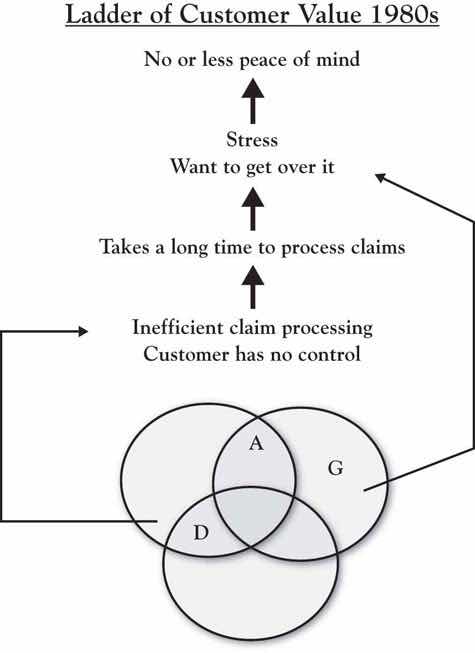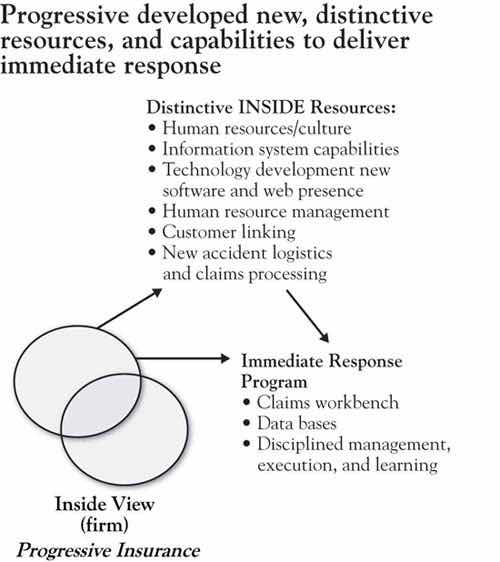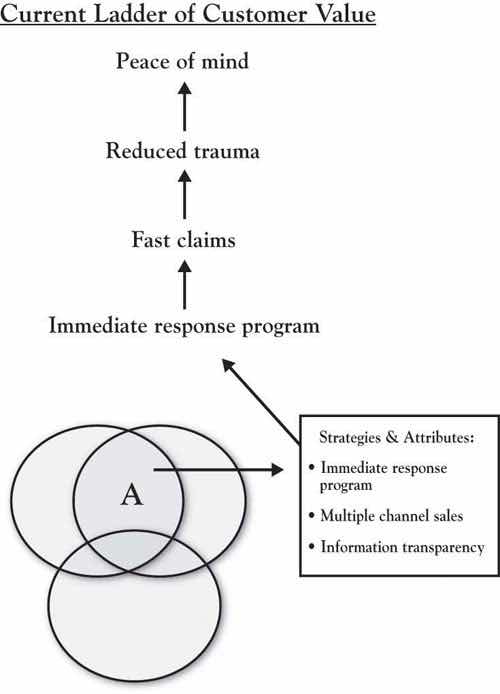The key challenge for management is to recognize internal capabilities, skills, resources, knowledge, networks, and so on that can be aggregated into bundles or competencies that can grow and sustain current value for the customers (Area A), have the potential of building new value by adding to Area A (E with potential for A), and must be maintained to deliver required attributes (Area B). While the resources within Area D may or may not be the type that will be appreciated and valued by customers, management must know them and make good decisions about what to do with them. Management must decide whether to remove or retain Area D resources. They may decide to retain Area D resources because they believe, correctly or incorrectly, that their competitors may build an advantage if they do not, or they can reconfigure resources and grow Area A. Yet keeping those resources can be a distraction and add unnecessary costs to the firm. Such blocks may be obsolete resources (inventory), outdated skills, and equipment, and, yet, management still holds on for fear of what competitors with those same resources may do. Still, there is a chance that they may be correct in their perception, and so management tends to retain, and even protect, Area D resources.
A building block in Area E has the potential of having attributes capable of growing Area A and strengthening Area B. One of the primary jobs of management is to find, sustain, and skillfully aggregate internal building blocks of core competencies to produce attributes that can lead to a differentiated, sustainable advantage (equity) in terms of features or cost, offering a limited, but highly desirable, subset of attributes.
A strategic bundle consists of the core building blocks that have the potential of bringing a sustainable competitive advantage to the company. Strategic bundles have the potential of being rare and unique not only because of the building blocks (skills, abilities, and knowledge) but also because of the way they combined to form the bundles.Barney (1991). Competitors may be able to imitate an asset or a resource, but it is extremely difficult for them to imitate the way they are combined with knowledge, skills, and experience to form a strategic bundle. Likewise, there is no substitute for a firm’s unique strategic bundle that creates product and service attributes valued by the customer.
Recall from the opening chapter of this book the situation faced by Peter Lewis of Progressive Insurance as he developed growth strategy in the 1990s. Consumer dissatisfaction with automobile insurance companies was high, particularly regarding claims-processing times. As depicted in Figure 7.7 "Automotive Insurance Industry Prior to Progressive Transformation: An Outside, Customer View", drilling down into this Area D disequity reveals its significance; it is ultimately connected to consumers’ peace of mind, an important driver of human behavior, particularly in a context as stressful as automobile accidents. Also recall that Peter Lewis had lost a younger brother in an auto accident and so had a deep understanding of the emotional trauma caused by an accident. After sensing the level of consumer dissatisfaction with the industry upon California’s passage of Proposition 103, which penalized the industry, Lewis reasoned that the most substantive way that Progressive could deliver value to customers was to create an “immediate response” capability that would dramatically reduce response times to auto accidents. Because this was born of real customer value and was very difficult to accomplish, it also had the potential to substantially differentiate Progressive from its competitors. But then the issue was how does a firm build such a capability?
Figure 7.7 Automotive Insurance Industry Prior to Progressive Transformation: An Outside, Customer View

Lewis set about developing strategies to deliver the peace of mind valued and desired by the market. He decided that a strategy of immediate response would deliver the distinctive value to bring this peace of mind and grow Area A. His strategy was to speed up claim processing in a more humane way that did not add to the trauma customers already suffered from the accident. To implement the strategy of a product with those service attributes, Lewis had to locate the resources, capabilities, and assets to successfully deliver the program. Attributes of the proposed program included an instant claims workbench, databases that were accurate and accessible to customers, committed and dedicated employees, and disciplined management. All of these proposed strategies and attributes are on the outside view of the 3-Circles model, viewed and appreciated by customers.
Next, Lewis had to determine whether he could implement his strategies and develop the required product and service attributes. This required Lewis to identify, develop, or acquire the internal resources, capabilities, and assets necessary to deliver the attribute and product value customers demanded that would bring peace of mind. He recognized that he would need radically different resources, assets, company culture, structure, and leadership to overcome the “high prices, bloated bureaucracies and poor service” characteristic of the industry.Salter (1998, October 31). His company shared the same skills, abilities, and technology as all other insurance companies. Lewis recognized that he needed a new resource bundle of resources, capabilities, and assets to deliver the value that customers desired. To provide immediate response, Lewis had to create an ultrafast, no-hassle, customer-friendly claims service. Internally, he had to develop an entirely new approach to human resources, including employees that were ready to serve customers 24 hours a day, 7 days a week. As Lewis put it, technology is not “worth a thing without topflight talent” and that they needed the “best people in the industry as measured by education, intelligence, initiative, work ethic and work record.”Salter (1998, October 31). The immediate-response team needed an information system with software that could efficiently manage a very smooth information flow. Within Progressive’s information-systems department, Lewis found competencies to develop software to enable the necessary concurrent information flow to make the service attributes that delivered the customer value. This information system has all the characteristics of a sustainable competitive advantage. The new information system and its management were necessary for implementing the information-transparency strategy. It also opened a sales channel for Progressive appreciated by customers and different from the exclusive direct sales approach utilized by other companies. While competitors have tried to imitate Progressive, “no other insurance company can instantly move information back and forth between a laptop and a mainframe and keep claims moving toward resolution.”Salter (1998, October 31). Lewis found he needed to add new assets to his resource bundle to deliver the attributes necessary to meet customer needs, including laptop computers and immediate-response vehicles. In short, to meet the market need Lewis had identified, he needed to develop a resource bundle by looking both inside and outside Progressive, for the new resources, capabilities, and assets necessary to bring the peace of mind his clients desired. Figure 7.8 "Progressive: An Inside View" shows the internal view of Progressive and its competitors. Note that most of the distinctive, internal resources used to implement Lewis’s strategies are not visible to the customers. They will see the product and service and their associated attributes; however, they may not have any idea of what Progressive does to deliver them.
Figure 7.8 Progressive: An Inside View

It is the inside resources, capabilities, and assets that brings Progressive its sustainable competitive advantage. Progressive’s resource bundle consists of DNA that is valuable (it satisfies the client value of “peace of mind”); is rare (no other company has the resource bundle); cannot be copied (Progressive consistently stays ahead of its competition that consistently tries to imitate their bundle); and that has no close substitutes. In 1998, the industry as a whole had experienced 5 years of underwriting losses. During that same time period, Progressive had underwriting margins of over 8% and annual revenues in excess of $4 billion, up 36% from the previous year.Salter (1998, October 31). Recognizing the attributes that customers value and developing and capitalizing upon Progressive’s resources, capabilities, and assets has helped the company develop and grow its distinctive advantage, that is, its Area A. Figure 7.9 "Automotive Insurance Industry After Progressive Transformation: Outside Customer View" shows the value ladder of the Progressive customers after its transformation. Progressive’s internal resources enabled the company to deliver the attributes recognized by customers and bring them the peace of mind they desired.
Figure 7.9 Automotive Insurance Industry After Progressive Transformation: Outside Customer View
